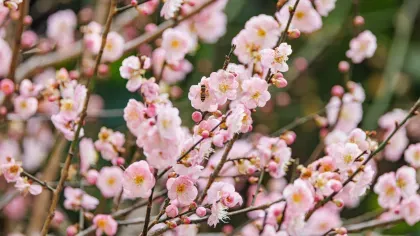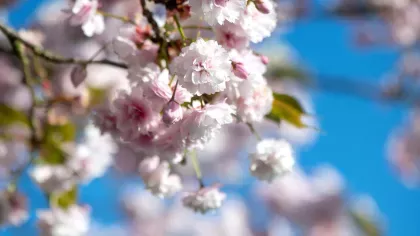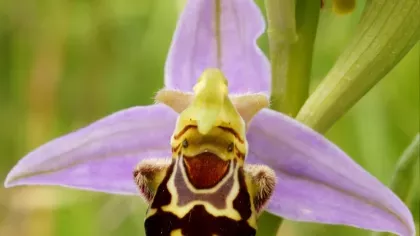Unravelling the evolutionary history of Aloes
Plantasia, Kew’s summer festival celebrating the positive effects of plants, is underway. Researcher Olwen Grace highlights investigations in the Jodrell Laboratory on Aloe vera, one of the most widely used plant species in the world today, and other aloes.

Cast your mind back to the supermarket products you used this morning as you prepared for your day. Chances are at least one of them contained Aloe vera, or perhaps you have it growing in a pot on your windowsill.
Aloe taxonomy and biology
The term ‘aloe’ is commonly applied to over 600 species in the genera Aloe, Aloidendron, Aloiampelos, Kumara, Gonialoe and Aristaloe, a group of plants native to Africa, Madagascar and the Arabian Peninsula. Of these, Aloe is the largest genus, with over 500 species. Aloes typically have rosettes of succulent leaves with sharp teeth along the margins, and orange or red tubular flowers grouped in an inflorescence. There are many exceptions, however, and exactly how all these species are related has long puzzled plant taxonomists.
Scientists at Kew have been studying aloes for decades, and some important breakthroughs have been made here since the 1970s. A substantial body of research on the chemistry, morphology, and chromosomes of Aloe was conducted in the Jodrell Laboratory by Tom Reynolds, David Cutler, Peter Brandham and colleagues, resulting in new findings on the leaf exudate chemistry, leaf surface sculpturing, cytology and genetics.
Several species of Aloe have been described at Kew, or named for a Kew botanist. Aloe gilbertii, for instance, is an Ethiopian endemic species named for Mike Gilbert by his former PhD student, Sebsebe Demissew, head of the National Herbarium at Addis Ababa University. Taxonomist Susan Carter and co-authors recently published an expansive illustrated guide to aloes (Carter et al., 2011) known admiringly as ‘the big aloe book’. The comparatively diminutive Aloe Names Book (Grace et al., 2011), published with colleagues at the South African National Biodiversity Institute (SANBI), lists all the names and common names of aloes in use today and historically. Like many charismatic plant groups, Aloe nomenclature is complicated. Multiple botanical and common names are applied to many taxa, and the resulting confusion can hinder all activities which rely on an accurate plant name, from the horticultural trade to the successful implementation of conservation and trade regulations.
Unravelling evolutionary history
Current research on aloes in the Jodrell Laboratory focuses on unravelling their evolutionary history based on phylogenetic analyses of DNA sequence data. Working with an international team of collaborators in Africa and Europe, the ultimate aim of my research is to reconstruct a complete phylogeny of the aloes. Building a phylogenetic tree for a large, taxonomically complex group such as the aloes is exciting work for a plant scientist. Some of the challenges include obtaining well-preserved material from species in inaccessible or inhospitable habitats, extracting quality DNA in the laboratory, and ensuring the plant specimens are accurately identified. The research to date has shed new light on relationships among ‘true aloes’ in the genus Aloe, the tree aloes (Aloidendron), scrambling aloes (Aloiampelos) and the unusual fan-leaved Cape endemic genus Kumara (Grace et al., 2013a).
A broad sampling of species, representing the tremendous morphological and habitat diversity of aloes, is the first step in establishing an evolutionary hypothesis for these plants. This comprehensive sampling approach will enable us to reach sound conclusions on the most likely scenarios leading to the patterns of species diversity observed today, and make predictions about possible future scenarios. All aloes have succulent leaves which enable them to withstand periodic drought, but not all are found in particularly arid habitats. Some species even prefer deep shade or wet rock faces.
Fieldwork with local experts is important to collect material for the herbarium and tissue collections at local institutes, as well as those at Kew. Rare aloes are increasingly threatened by habitat loss, and these species are one of the focal points for my collecting trips on the African continent, and for Solofo Rakotoarisoa in the Kew Madagascar Conservation Centre.
Living collections at Kew
Observing plants in habitat is essential for understanding their ecology, but well-curated living collections are a good source of plant material to expedite the process of extracting and sequencing DNA for evolutionary studies. The collection of succulent plants at Kew, managed by horticulturist Paul Rees, is pivotal to research carried out miles away from the plants in their natural habitat. This behind the scenes collection is carefully curated as a scientific resource to support conservation and research. Rows of potted plants are ordered taxonomically but this doesn’t detract from the spectacle of aloes in flower in the glasshouse. Paul and I work together to ensure plants are correctly labelled with updated names, identify species we’d like to have represented in the collection, and undertake field work to ensure that Kew’s collection plays a meaningful role in the ex situ conservation of this important group of plants.
Natural capital
Aloes feature on stamps, coins and logos and are arguably as iconic in Africa as flat-crowned acacia trees. Many aloes flower during the dry season when the landscape is bleakest, providing spectacular floral displays and an important source of nectar for birds. A close look at the uses recorded for Aloe and related genera has shown that, although many species are used for home remedies, their value is greatest in veterinary medicine (Grace et al., 2009).
The enormous industry which brings Aloe vera to supermarket commodities, cosmetics and foods, is centred on the carbohydrate-rich succulent leaf tissue from cultivated Aloe vera plants. Surveys of the diversity of constituent sugars have shown interesting taxonomic and phylogenetic patterns (Grace et al., 2013b) and have stimulated further research with colleagues at the University of Copenhagen to investigate carbohydrate structure in the leaves of true aloes, including Aloe vera.
Next steps
The first phase of phylogenetic research, reconstructing the evolutionary history of aloes in Africa and their biogeography, will soon be complete. The next steps are to delve deeper into species relationships among aloes using genomic tools, leading eventually to a revised classification of the aloes. Evolutionary studies are the first step towards appreciating the species diversity of aloes, facilitating their conservation and unlocking their potential to be used in the future.
Aloes are on display year-round in the arid zone of the Princess of Wales Conservatory at Kew.
References
- Carter, S., Lavranos, J.J., Newton, L.E. & Walker, C.C. (2011) Aloes: the Definitive Guide. Royal Botanic Gardens, Kew. Available to buy online
- Grace, O.M., Klopper, R.R., Figueiredo, E. & Smith, G.F. (2011). The Aloe Names Book. Royal Botanic Gardens, Kew; South African National Biodiversity Institute, Pretoria. Available to buy online
- Grace, O.M, Klopper, R.R., Smith, G.F. Crouch, N.R., Figueiredo, E., Rønsted, N. & Van Wyk, A.E. (2013a). A revised generic classification for Aloe (Xanthorrhoeaceae subfam. Asphodeloideae). Phytotaxa 76: 7-14. Available online: Available online
- Grace, O.M., Dzajic, A., Jager, A.K., Nyberg, N., Onder, A. & Rønsted, N. (2013b). Monosaccharide composition of succulent leaf tissue in Aloe. Phytochemistry 93: 79–87. Available online
- Grace, O.M., Simmonds, M.S.J., Smith, G.F., van Wyk, A.E. (2009). Documented utility and biocultural value in the genus Aloe L. (Asphodelaceae): a review. Economic Botany 63: 167–178. Available online



